- VMware
- VMware vCenter Server (VCSA), VMware vSphere
- 17 July 2024 at 12:55 UTC
-

- 1/2
From the "vSphere Client" web interface of your VMware vCenter Server (or VCSA), you can manage your virtual machines and obtain a lot of information about them.
- Summary (Virtual machine information)
- Actions for the virtual machine
- Monitor the virtual machine
- Configure the virtual machine
- Manage permissions on a virtual machine
- Datastores
- Virtual networks
- Updates
1. Summary (Virtual machine information)
When you select a virtual machine, you will first see its name, as well as several icons allowing you to perform the most common actions:
- Power On: start the virtual machine
- Shut Down Guest OS: properly shut down the virtual machine by triggering the shutdown of the operating system installed in it.
Requires VMware Tools to be correctly installed in this virtual machine. - Launch Console: allows you to access the console of this virtual machine.
By default, you will have the choice between "Web Console" and "VMware Remote Console (VMRC)". Except, if you have previously checked the "Remember my choice" box.
If this is the case, you can always change the default choice by clicking on the name of your account (top right), then on: My Preferences -> Default Console. - Edit Settings: allows you to modify the virtual hardware of the virtual machine, as well as the VM options.
- Take Snapshot: allows you to take a snapshot of the virtual machine.
- Actions: provides access to a menu offering numerous actions for your virtual machine.
All actions available in this menu are described in the next step of this article.
By default, you will find yourself in the "Summary" tab in which you can see:
- Thumbnail: a preview of the console (screen) of your virtual machine
- Guest OS: the name of the operating system installed in this virtual machine.
More specifically, this is the guest operating system selected when you created your virtual machine.
It is on this information that VMware vCenter Server (or VCSA) will be based to insert the correct VMware Tools ISO file and that VMware products will adapt certain system parameters to ensure compatibility with the guest operating system installed there. - Compatibility: level of compatibility of this virtual machine with your VMware ESXi hypervisor and version of the virtual hardware used.
If necessary, consult the "Virtual machine hardware versions (1003746)" page to find out which versions of VMware products are supported for each version of VMware virtual hardware. - VMware Tools: allows you to know if the VMware Tools are installed, know the version of them (if they are installed), as well as if they are up to date.
- DNS Name: allows you to know the full name (FQDN / DNS) or the NETBIOS name (otherwise) defined in the guest operating system.
However, this information is only available when the virtual machine is started since this information is retrieved via the VMware Tools which must be installed beforehand in the virtual machine's guest operating system. - IP Addresses: allows you to know the IPv4 address of this virtual machine, as well as its other IP addresses (notably IPv6) by clicking on the "Show all 2 IP addresses" link (if applicable).
- Host: allows you to know the name of the host (VMware ESXi hypervisor) on which this virtual machine will be or is running.
On the right, when the virtual machine is started, you will be able to see in real time:
- CPU usage by this virtual machine
- Memory usage (RAM) by this virtual machine
- Storage usage
Below the virtual machine console preview, you can choose to:
- Launch Web Console: to control your virtual machine from a new tab of your favorite web browser.
- Launch Remote Console: to control your virtual machine more easily using the free program "VMware Remote Console" (VMRC) or the paid virtualization software "VMware Workstation Pro" which also supports the "vmrc://" protocol.
You will also see several blocks allowing you to obtain information about:
- VM Hardware: the list of different components (virtual hard disk, virtual controller, ...) and resources (CPU, RAM, ...) of this virtual machine.
- Related Objects: the different objects created by VMware vCenter concerned by this virtual machine, such as the datastore where it is located and the virtual network used by it.
- Tags: the list of tags and categories assigned to this virtual machine.
- Notes: notes (comments) that you added manually on this virtual machine.
- Custom Attributes: similar to the tags explained above (but available in VMware vSphere longer than tags).
- VM Storage Policies: allows you to create policies for storing VMs that are based on hosts, virtual volumes or tags.
Note that these blocks can be moved so you can rearrange them however you want.

For information regarding VMware Tools, if you click on the "More info" link, you will be able to see:
- Running Status: indicates whether VMware Tools is running (when the VM is started) or not (inactive).
- Version: the version of VMware Tools that are installed in the guest operating system.
- Version Status: indicates whether the VMware Tools are up to date (Current) or not, as well as how they are managed.
- Installation Type: indicates how the VMware Tools were installed (only if the VM is started).
For example: MSI (on Windows 10 via the appropriate VMware Tools ISO file), Open-source VMware Tools (on Linux when you use the "open-vm-tools" packages), ...

The 1st block that you will see below the summary of your virtual machine is "VM Hardware" with:
- CPU: the number of virtual processors (whether these are seen as separate virtual processors and/or as processor cores).
- Utilization: number of processors and/or processor cores, as well as the processor utilization rate in MHz or GHz.
- Shares: allows you to manage the relative importance for sharing system resources (in this case: the processor).
The default values are: 1000 (low importance), 2000 (normal importance), 4000 (high importance) or a custom value (if desired). - Reservation: ensures that the virtual machine can use at least x MHz or GHz by reserving part of the frequency of the physical processor for it.
- Limit: allows you to limit a virtual machine transparently by specifying a frequency in MHz or GHz.
Assuming that you assign 2 processor cores to this VM and that your processor has a base frequency of 3 GHz, your VM will be able to use a maximum frequency of 6 GHz (from the vCenter point of view).
If you specify a limit of 3 GHz, the virtual machine will only be able to use its virtual processor at 50% of its capacity. The usage rate displayed by the task manager (on Windows) available in the guest operating system will therefore never exceed 50%.
This can be useful if software requires a certain minimum number of cores to install, but you do not want this virtual machine to use too much of your physical processor. - Hardware virtualization: indicates whether CPU virtualization features (Intel VT-x / AMD-V) are visible to the guest operating system or not.
If this setting is enabled, you will be able to install a hypervisor or other virtualization software in this virtual machine. - IOMMU: indicates whether input/output (I/O) virtualization is enabled or not. Which corresponds to the technologies: IOMMU (at AMD) and VT-d (at Intel).
If this setting is enabled, you will be able to use PCI passthrough and virtualization-based security (VBS). - Performance counters: performance counters are useful only for programmers (developers) who want to use profiling software to analyze and improve the performance of their own programs.
- Memory: amount of RAM allocated to the virtual machine, as well as the amount of RAM in MB or GB currently used by this VM.
- Utilization: amount of RAM allocated and currently used by the VM.
- Shares: allows you to manage the relative importance for the host's RAM usage in the event that physical RAM begins to run out and multiple virtual machines attempt to use more RAM.
The principle being the same as for the processor (CPU), as explained previously. - Reservation: ensures that this virtual machine can use at least the amount of RAM indicated here.
Note that if you wish to pass a physical device to your virtual machine using PCI passthrough, you will be required to reserve all the RAM allocated to this virtual machine.
Otherwise, the virtual machine will not start. - Limit: allows you to allocate, for example, 4 GB of RAM to a virtual machine, but prevent it from using more than 2 GB (for example).
The task manager (under Windows) available in the operating system will therefore indicate to the user that he has 4 GB of RAM, but he will not be able to exceed the limit defined here (for this example: 2 GB). - VM overhead consumed: this is the amount of memory used by VMware ESXi for its data structures and its own code, as well as the time required to access virtual RAM.
Indeed, there is a slight delay created by VMware ESXi when accessing the virtual machine's RAM.
Source: Understanding Memory Overhead.
The amount of additional memory used generally varies between 20 MB and 200 MB and depends on the amount of random access memory (RAM) allocated to the virtual machine, as well as the number of virtual processors (CPUs) assigned to it.
Source: Overhead Memory on Virtual Machines.
- Hard disk x: maximum capacity of this virtual hard disk.
- Capacity: same as above.
- Type: indicates whether it is a dynamic provisioning (the virtual hard disk only takes up the space necessary for the data contained in it) or a static provisioning (the space is pre-allocated on the physical disk for better performance, but at the risk of unnecessarily consuming a lot of disk space).
- Location: name of the datastore in which this virtual hard disk is located, as well as the amount of free space available on it.
- Network adapter x: name of the virtual network this virtual machine is connected to, as well as whether it is currently connected to this virtual network or not.
Note that a virtual machine is never connected to the network if it is powered off.- Adapter Type: indicates which type of network adapter (network card) is emulated, virtualized, or paravirtualized.
A paravirtual network adapter allows you to benefit from better network performance, but the choice is made by default by VMware to use a network card natively supported by the guest operating system installed in this virtual machine. - MAC Address: indicates the MAC address (physical/hardware address) of this virtual network card.
MAC addresses used under VMware vCenter Server have the prefix "00:50:56" which corresponds to the VMware OUI (Organizationally Unique Identifier). - DirectPath I/O: indicates whether this is a physical network card passed to the virtual machine.
- Network: indicates the name of the virtual network to which it is connected, as well as its connection status.
However, if the virtual machine is powered off, its status will still be "disconnected".
- Adapter Type: indicates which type of network adapter (network card) is emulated, virtualized, or paravirtualized.
- CD/DVD drive x: indicates whether the VM's virtual CD/DVD drive is currently connected or not.
This can be connected to the physical CD/DVD drive of the host, a client PC via VMware Remote Console (VMRC) or to an ISO file).- Connected to: indicates whether this virtual CD/DVD drive is connected to a client PC's physical CD/DVD drive, the host CD-ROM device, a host image file, or a content library image file.
- Device: in the case of the host's physical CD/DVD drive (VMware ESXi), indicates the path of the device used (/vmfs/devices/cdrom/...).
- File: in the case of a host ISO file, indicates the name of the database, as well as the full path of the ISO file inserted in this virtual CD/DVD drive.
If the file is stored in a content library on your vCenter Server, the path will start with "contentlib-[content library identifier]".
- Video card: video memory allocated to this virtual machine.
- Total video memory: amount of video memory allocated to this VM.
- Number of displays: number of screens usable on your computer from this virtual machine.
- 3D Graphics: indicates whether or not 3D is supported by this virtual machine.
- 3D Renderer: indicates how 3D will be handled by this virtual machine. In software or hardware.
- 3D Memory: amount of 3D memory allocated to this virtual machine.
- VMCI device: device ensuring communication between the virtual machine and the hypervisor via a PCI bus.
- Other: indicates additional hardware used by this virtual machine.
- Controllers: list of virtual controllers used by your virtual machine, such as a USB EHCI controller (for USB 2.0) or xHCI (for USB 3.0), a SATA controller (for the virtual CD/DVD drive, for example), a PS2 controller (for keyboard virtualization), ...
- SCSI Adapters: a SCSI controller to connect virtual hard drives to when a compatible (recent) guest operating system is used.
One of the advantages is being able to easily connect and disconnect virtual hard disks while hot. - Input Devices: keyboard and mouse (pointing device) virtualized by VMware for the proper functioning of the virtual machine.
- Compatibility: indicates the compatibility level of the virtual machine (for example: ESXi 6.7 and later), as well as the version of the virtual hardware used (which corresponds to the compatibility level of the VM).
To modify the virtual hardware of this virtual machine, you have the option to click on the "Edit Settings" link located at the bottom of this table or to click on the 4th icon next to the name of your virtual machine.

For each virtual machine, you will be able to know the "Related Objects":
- Host: VMware ESXi hypervisor on which the virtual machine is located.
- Networks: virtual network (or "Port Group" on VMware ESXi) to which the virtual machine is connected.
- Storage: datastore in which this virtual machine is stored.

For each virtual machine, you can assign different tags.
These tags are meta-data allowing, for example, to easily find some virtual machines.
This notion of tags appeared with vSphere 5.5 and succeeds custom attributes.

In the "Notes" block, you will be able to see and/or modify the notes (comments) that you wish to indicate for this virtual machine.

In the "Custom Attributes" block, you will be able to see and modify the list of custom attributes assigned to this virtual machine.

In the "VM Storage Policies" block, you will be able to find out:
- VM Storage Policies: the storage strategy used for the VM.
The VM storage policy can be host-based, tag-based, or Virtual Volumes. - VM Storage Policy Compliance: allows you to check if the VM is using a datastore that is compatible with the VM storage policy used.
- Last Check Date: indicates the last time the storage rule used was checked for compliance.
- VM Replication Groups: name of the VM replication group.
Sources :
- Creating and Managing VM Storage Policies - VMware Docs
- Check Compliance for a VM Storage Policy - VMware Docs

2. Actions for the virtual machine
To the right of the name of your virtual machine and its action icons, you will find an "ACTIONS" menu.
Note that this "Actions" menu is also available by simply right-clicking on the name of the virtual machine in the left column.

Thanks to this "Actions" menu, you can:
- Power: start, restart, stop, ... the virtual machine.
- Guest OS: launch the installation or update of VMware Tools, customize the guest operating system, etc.
- Snapshots: manage virtual machine snapshots.
- Open Remote Console: access the virtual machine console using the free "VMware Remote Console" (VMRC) program or any other VMware program compatible with the "vmrc://" protocol.
- Migrate: migrate the execution and/or storage of a virtual machine from one VMware ESXi host to another.
- Clone: clone the virtual machine or convert it to a template on a VMware ESXi host or to a content library.
- Fault Tolerance: allows you to protect the execution of a virtual machine against the failure of a host thanks to a mirror copy of it which will be synchronized in real time on another server.
- VM Policies: manage VM storage policies and verify rule compliance of these VM storage policies.
- Template: convert this virtual machine into a model or export it in OVF format.
- Compatibility: change the compatibility level of the virtual machine.
- Export System Logs: troubleshoot unresponsive virtual machines.
- Edit Settings: change the virtual hardware and VM options of the virtual machine.
- Move to folder: move this virtual machine to another folder in the "VMs and templates" tab.
- Rename: rename the virtual machine.
- Edit Notes: add/edit the notes (comments) you want to indicate for this virtual machine.
- Tags & Custom Attributes: assign/remove tags for this virtual machine, as well as manage custom attributes associated with it.
- Add Permission: add a new authorization for a user (already existing) using a previously created and configured role.
- Alarms: manage alarms regarding this virtual machine.
- Remove from inventory: remove the virtual machine from your inventory without deleting its component files.
Which means that it will no longer be referenced on your VMware vCenter Server), but you will be able to find its various files (.vmx, .vmdk, ...) in the datastore where it is currently located. - Delete from Disk: delete the virtual machine from the inventory AND permanently delete its component files (including its virtual hard disk).
- Update Manager: allows you to update the VMware Tools or virtual hardware of the virtual machine to match that of the host.

In the "Power" submenu you will find the options:
- Power On: start the virtual machine
- Power Off: suddenly shut down the virtual machine by virtually cutting power to it.
- Suspend: pause the virtual machine
- Reset: abruptly restart the virtual machine as if you had pressed the "Reset" button on this virtual computer.
- Shut Down Guest OS: shut down the virtual machine properly by shutting down the guest operating system normally.
- Restart Guest OS: cleanly restart the virtual machine by restarting the guest operating system.
Important : the 2 options concerning the guest OS require that VMware Tools be installed in the virtual machine.

In the "Guest OS" submenu, you will find the options:
- Answer Question: allows you to redisplay the question that VMware vCenter Server may have asked you and to which you have not yet answered.
- Install VMware Tools: insert the appropriate VMware Tools ISO file into the virtual machine's virtual CD/DVD drive to install VMware Tools.
- Upgrade VMware Tools: allows you to launch the upgrade (which can be done silently by default) of the VMware Tools.
- Unmount VMware Tools installer: forces removal of the VMware Tools virtual CD from the virtual CD/DVD drive.
However, by default, this virtual CD is automatically ejected from the guest operating system once the VMware Tools installation is complete. - Customize Guest OS: allows you to personalize the guest operating system using a previously created customization specification.
- Guest User Mappings: allows SSO users to perform administrative tasks, such as installing VMware Tools (for example) if the virtual machines are configured correctly (VGAuth authentication via X.509 certificates).

In the "Snapshots" submenu, you will find the options:
- Take Snapshot: allows you to take a snapshot of your virtual machine.
- Manage Snapshots: allows you to manage snapshots created on this virtual machine.
- Revert to Latest Snapshot: allows you to quickly restore the state of the virtual machine to the previous state using the last snapshot that you previously created.
- Consolidate: allows you to recover disk space by deleting redundant and/or unnecessary data that may be lying around following the creation and/or deletion of snapshots on this virtual machine.
- Delete All Snapshots: allows you to consolidate all snapshots with the virtual machine's base disk, then deletes all snapshots (= the possibility of going back to them) to reclaim disk space.
The current state of the guest operating system and the data accessible from it will therefore remain unchanged.

In the "Clone" submenu you will find the options:
- Clone to Virtual Machine: create a copy of this virtual machine on your VMware vCenter Server.
- Clone to Template: allows you to create a copy of this virtual machine and convert this copy into a template.
- Clone as Template to Library: same as the previous option, but the template will be stored in a content library.

In the "Fault Tolerance" submenu, you will find the options:
- Turn On Fault Tolerance: enables fault tolerance on this virtual machine.
- Turn Off Fault Tolerance: allows you to disable fault tolerance on this virtual machine.
- Resume Fault Tolerance: allows you to resume the fault tolerance process after having paused it
- Suspend Fault Tolerance: allows you to pause (interrupt) the fault tolerance process
- Migrate Secondary: allows you to migrate (move) the secondary virtual machine associated with it to another VMware ESXi host.
- Test Failover: allows you to test the fault tolerance of this virtual machine by defining the secondary virtual machine as the primary one (and vice versa).
- Test Restart Secondary: allows you to test the fault tolerance of the virtual machine by causing the failure of the secondary virtual machine (which provided fault tolerance for it).

In the "VM Policies" submenu, you will find the options:
- Edit VM Storage Policies: allows you to edit the VM storage policy to use for the virtual machine and its virtual hard disk.
- Check VM Storage Policy Compliance: allows you to check if the virtual machine is using a datastore compatible with the storage policy selected for it.
- Reapply VM Storage Policy: when you modify a VM storage policy that is already selected for this virtual machine, this action reapplies the VM storage policy to it so that the new settings for this policy are applied.

In the "Template" submenu, you will find the options:
- Convert to Template: converts a virtual machine to a template. It is therefore no longer startable, but it still appears in the "VM and models" tab.
- Export OVF Template: allows you to export the virtual machine in OVF format.
If you prefer to obtain the virtual machine in VMware format (with a ".vmx" configuration file), download it via VMware Workstation.

In the "Compatibility" submenu, you will find the options:
- Upgrade VM Compatibility: allows you to upgrade the VM compatibility level to a newer version to take advantage of new features offered by recent versions of VMware ESXi.
Note that you will not be able to revert to an older version. - Schedule VM Compatibility Upgrade: allows you to schedule this VM compatibility upgrade during the next restart of this virtual machine.
- Cancel Scheduled VM Upgrade Upgrade: allows you to unschedule this VM compatibility upgrade.

In the "Tags & Custom Attributes" submenu, you will find the options:
- Assign Tag: allows you to assign tags (previously created) to this virtual machine.
Tags are metadata that you can add to different types of objects.
Note that tags succeed custom attributes since vSphere 5.5. - Remove Tag: allows you to delete tags that you have previously assigned to this virtual machine.
- Edit Custom Attributes: allows you to edit custom attributes previously added to this virtual machine.

In the "Alarms" submenu, you will find the options:
- New Alarm Definition: allows you to define a new alarm for this virtual machine to see and/or receive an alert when the desired conditions are no longer respected.
- Enable Alarm Actions: enables actions configured in the alarm definitions defined on this object.
- Disable Alarm Actions: allows you to disable the actions configured in the alarm definitions defined on this object.
Warning: this will not disable actions configured in alarm definitions defined on a parent object.

In the "Update Manager" submenu, you will find the options:
- Upgrade VMware Tools to Match Host: allows you to upgrade or schedule the upgrade of the VMware Tools of one or more virtual machines to the latest version supported by the host.
- Upgrade VM Hardware to Match Host: similar to the previous option, but for upgrading the virtual hardware of the VM.

Share this tutorial
To see also
-
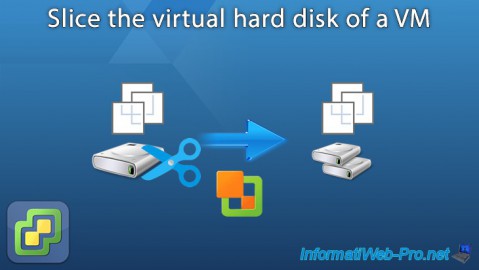
VMware 12/16/2022
VMware ESXi 6.7 - Slice the virtual hard disk of a VM
-
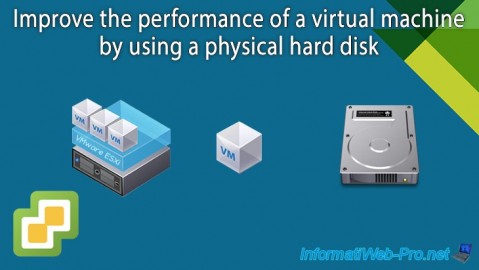
VMware 10/2/2024
VMware vSphere 6.7 - Improve the performance by using a physical HDD
-
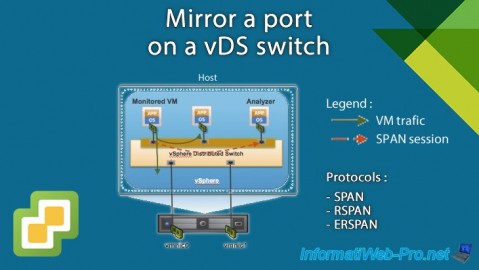
VMware 1/15/2025
VMware vSphere 6.7 - Port mirroring
-
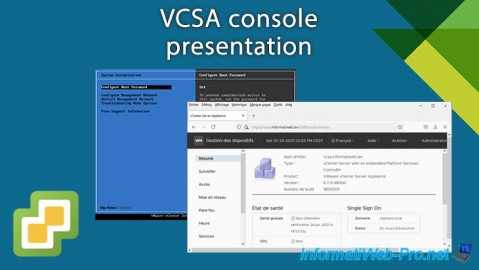
VMware 3/1/2024
VMware vSphere 6.7 - VCSA console presentation

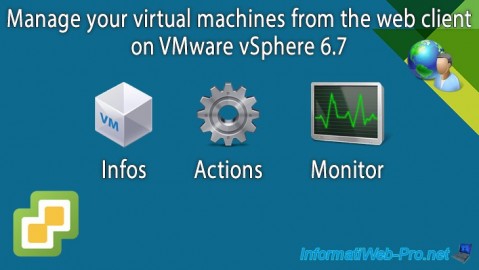
You must be logged in to post a comment